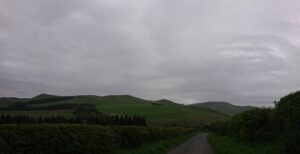 Breakfast with Boris: there’s a thought to make you shudder. The ubiquity of TVs in public places is a regular complaint of mine; and a screen with the loon in question was not what we wanted as we ate our croissants and eggs (not simultaneously; we’re not savages!) the following morning. There he was, though. We chatted a bit with another pair of walkers who were going as far as Kirk Yetholm today “though we might go further”. All the guidebooks were very clear that there was nothing but hills between Kirk Yetholm and Hethpool (where we were staying in the only available rooms), so why tell us that? What’s all that about?
Breakfast with Boris: there’s a thought to make you shudder. The ubiquity of TVs in public places is a regular complaint of mine; and a screen with the loon in question was not what we wanted as we ate our croissants and eggs (not simultaneously; we’re not savages!) the following morning. There he was, though. We chatted a bit with another pair of walkers who were going as far as Kirk Yetholm today “though we might go further”. All the guidebooks were very clear that there was nothing but hills between Kirk Yetholm and Hethpool (where we were staying in the only available rooms), so why tell us that? What’s all that about?
I did some cautious back-of-leg stretches on the tartan stairs before zipping up my bag for Mr Carrylite and putting on the daypack. Outside it was dry and there was a short pull up a rising road before we cut left over Kale Water (hands up who doesn’t want to drink that), using the footbridge as the river was flowing just that bit too smoothly and fast over the ford. We Nan Shepherded across fields, steadily rising towards Grubbit Law, then continued the slow climb towards Wide Open Hill. Mould could probably grow faster than I was moving but I was doing ok, and was rewarded with a shot of sheer joy and exhilaration as we hit the freedom of the high (relatively speaking) fell: hills and quiet and russets and browns and larks and sheep all around us; softly grey skies overhead. Wide open hill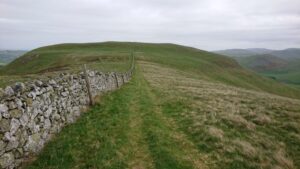 indeed. The exhilaration mellowed into a gentler, more steadily glowing sense of achievement and quiet delight in the surroundings. The hill had a lovely shape: it was like walking along a horse’s spine towards the soft round of its rump; so different from the rocks and crags of the Lake District fells I’m used to.
indeed. The exhilaration mellowed into a gentler, more steadily glowing sense of achievement and quiet delight in the surroundings. The hill had a lovely shape: it was like walking along a horse’s spine towards the soft round of its rump; so different from the rocks and crags of the Lake District fells I’m used to.
Reaching the summit of WOH, we stopped to rest and wrestle with the map in the wind. While we were grappling with it, two walkers were approaching from the other direction; poles and big packs: serious stuff. We had a brief chat, discovering that they were American visitors who had finished the Pennine Way the day before and 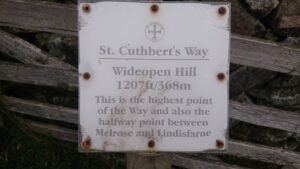 immediately started on another Way. They “weren’t feeling it today”, simply slogging away and ticking the miles off joylessly. It seemed the essence of product walking. Give me process any day, especially when I’m in a good bit, like I was now. Jenny wasn’t going to let me forget yesterday, though: as I scrabbled at a gate, biffing the latch to-and-fro and completely failing to register that there were in fact two catches, she quietly pointed out “Right action, wrong side”. Ah yes. “I thought I was doing better than yesterday—high functioning…?” I bleated. “Well, that depends on what level you were at then, doesn’t it?”. Ooyah.
immediately started on another Way. They “weren’t feeling it today”, simply slogging away and ticking the miles off joylessly. It seemed the essence of product walking. Give me process any day, especially when I’m in a good bit, like I was now. Jenny wasn’t going to let me forget yesterday, though: as I scrabbled at a gate, biffing the latch to-and-fro and completely failing to register that there were in fact two catches, she quietly pointed out “Right action, wrong side”. Ah yes. “I thought I was doing better than yesterday—high functioning…?” I bleated. “Well, that depends on what level you were at then, doesn’t it?”. Ooyah.
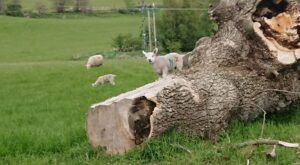 We followed a stegosaurus spine of wall down along a lower ridge through softly grassed fields of still-quite-small lambs. At the bottom there was a stretch of little-used green lane before a left turn onto a longish road section towards Kirk Yetholm. As we trundled along the low valley bottom, hills rose on either side—small, strangely pointy summits, like a child’s drawing of hills. Everywhere, everything was all so brightly green and freshly starting: absolutely delicious. A short bit of “main-er” road before a left turn onto a track towards the village, which took us past a field with a rather grumpy looking Shetland pony (perhaps it had walked from Jedburgh yesterday). The Bowland Water meandered on our right, its narrow winding channels curving round stone banks (complete with nesting oyster catcher) and gorse-y islets. Past the power station, over the bridge, left across the green, right down lane past the youth hostel and then a couple of minutes’ climb to the green where we had crisp sandwiches in the sunshine, sitting on a bench looking at across at the Border Hotel and wondering if that sign over there really did say “Penial Revival Centre”. (We checked later. It did.)
We followed a stegosaurus spine of wall down along a lower ridge through softly grassed fields of still-quite-small lambs. At the bottom there was a stretch of little-used green lane before a left turn onto a longish road section towards Kirk Yetholm. As we trundled along the low valley bottom, hills rose on either side—small, strangely pointy summits, like a child’s drawing of hills. Everywhere, everything was all so brightly green and freshly starting: absolutely delicious. A short bit of “main-er” road before a left turn onto a track towards the village, which took us past a field with a rather grumpy looking Shetland pony (perhaps it had walked from Jedburgh yesterday). The Bowland Water meandered on our right, its narrow winding channels curving round stone banks (complete with nesting oyster catcher) and gorse-y islets. Past the power station, over the bridge, left across the green, right down lane past the youth hostel and then a couple of minutes’ climb to the green where we had crisp sandwiches in the sunshine, sitting on a bench looking at across at the Border Hotel and wondering if that sign over there really did say “Penial Revival Centre”. (We checked later. It did.)
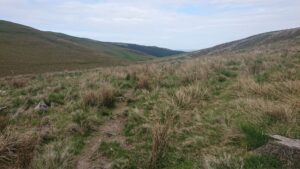 After tea and free shortbread at the hotel we set off for part two of the day’s walk. There was a steady climb up a road away from Kirk Y, and Ron told us we were looking out for a “grassy area”. Gee, ta. There was more long slow up but for whatever reason I was handling it all far better than yesterday. Perhaps Day 4 Acceptance followeth Day Three Syndrome as a zenith does a nadir? Whatever was going on, I was very glad of it. The narrow path contoured round little summits on whose slopes lambs were enjoying those full-commitment-to-sleep afternoon naps—lying on their side with their little legs stretched sweetly in front of them, neatly crossed. The landscape here up high was gentle and encouraging, with traceries of walls here and there, many clumps of fescue, and a mellow palette of ochres, browns and greens. Aware that we were approaching the border, we also felt reluctant to leave Scotland. There was a point where we had to turn for our last look at the Eildons. As we stopped at the border stile to drink to our achievements and say
After tea and free shortbread at the hotel we set off for part two of the day’s walk. There was a steady climb up a road away from Kirk Y, and Ron told us we were looking out for a “grassy area”. Gee, ta. There was more long slow up but for whatever reason I was handling it all far better than yesterday. Perhaps Day 4 Acceptance followeth Day Three Syndrome as a zenith does a nadir? Whatever was going on, I was very glad of it. The narrow path contoured round little summits on whose slopes lambs were enjoying those full-commitment-to-sleep afternoon naps—lying on their side with their little legs stretched sweetly in front of them, neatly crossed. The landscape here up high was gentle and encouraging, with traceries of walls here and there, many clumps of fescue, and a mellow palette of ochres, browns and greens. Aware that we were approaching the border, we also felt reluctant to leave Scotland. There was a point where we had to turn for our last look at the Eildons. As we stopped at the border stile to drink to our achievements and say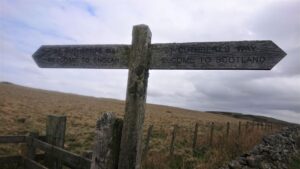 goodbye to the land we had laid claim to, the brown shape of a hare loped freely across the adjacent field. Lovely lovely lovely. We sighed, and turned away.
goodbye to the land we had laid claim to, the brown shape of a hare loped freely across the adjacent field. Lovely lovely lovely. We sighed, and turned away.
As we climbed down into England a chill wind sprang up and the sky lowered and blackened. It was hard not to see this as a metaphor, particularly since we’d been talking about applying sunscreen only an hour before and were now huddling hurriedly into our cags. Underfoot, the way became boggy, uneven and unpleasant, and behind us a loud, leery group disrupted our companionable silence with loud jeers and joshing as one of the party got his feet wet in a particularly boggy bit. Then there was the Mystery of the Invisible Forest, which was clearly marked on the map but nowhere to be seen in the actual landscape in front of us. After a few minutes’ cognitive dissonance and deep nav-related self-doubt, we found ourselves walking through a field of tree stumps, and suddenly it all made sense. We picked out way through, Jenny clunking her head on the strange cross-pieces at the top of the stiles with whose fastenings I was (still) struggling. Latch a-copia. Some cows and calves stood watching us as we descended. They had gorgeously ruffled long coats in rich browns and creams and were strangely clean, as if freshly coiffed. Beyond them were more wooded slopes—actual visible forest, in this case—where (according to Ron) Lord Collingwood had planted many oaks in order to provide Nelson with warship-building material. He planted them about 200 years too late, but still got a lordship for his trouble.
Discussing why today was so much better than yesterday, we wondered how much of it was to do with footwear. Jenny proved to be very well informed indeed about socks, and was fascinating on the function of layers and padding and suiting one’s sock to one’s boot and/or the terrain. I listened with interest, wondering aloud how she knew so much about it. Now, Jenny is one of the least acquisitive and genuinely simple-living people I know: she introduced me to the Minimalism Game and the joy of decluttering, and her house is not one of those stark monochrome temples to ostentatious minimalism (if that’s not an oxymoron) but, rather, an orderly yet comfortable and attractive space where—to my eyes anyway—there is nothing that is not either useful or beautiful. However, in the course of the sock talk it emerged that socks are, as it were, her Achilles heel; the portrait in the attic. When I tell you that she could put on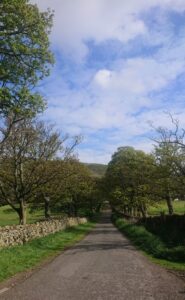 clean socks every day for over two months without ever having to wash a pair, you will get some sense of the problem…
clean socks every day for over two months without ever having to wash a pair, you will get some sense of the problem…
A beautiful avenue of trees lead us down the road towards Hethpool. In order to preserve the quiet greenness, access for cars is restricted at certain times; and boy is it worth it. Such a sense of a haven, tucked between softly rounded russet and ochre hills. We discovered that Hethpool House was the most glorious country dwelling, small, unfussy, filled with antique treasures, what seemed like a tumbling carpet of dogs, many hunting-related pictures and the fragrance of great bunches of flowers gathered from the gardens (with just a hint of dog). (There was also the best dog stairgate I have ever seen). Our hostess Eildon Letts—a case of nominative determinism?—made us extremely welcome, with a tray of tea and lavish home-made 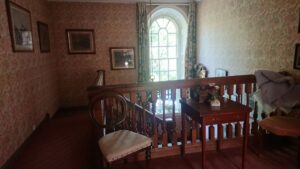 cakery. My mouth was open, drinking it all in, as she showed us to our rooms. If you can imagine a cross between one of the (then) Queen’s country homes, an unstuffy National Trust property and the set of a BBC period drama, perhaps an Agatha Christie, with outstandingly high production values—all of this on a small, unintimidating scale—well, that’s what this was like. Jenny’s room had two beds with ridiculously high, princess and the pea mattresses, and a basin in the corner which had no plughole but, instead, some cunning waste-disposal slots which magically retained the water
cakery. My mouth was open, drinking it all in, as she showed us to our rooms. If you can imagine a cross between one of the (then) Queen’s country homes, an unstuffy National Trust property and the set of a BBC period drama, perhaps an Agatha Christie, with outstandingly high production values—all of this on a small, unintimidating scale—well, that’s what this was like. Jenny’s room had two beds with ridiculously high, princess and the pea mattresses, and a basin in the corner which had no plughole but, instead, some cunning waste-disposal slots which magically retained the water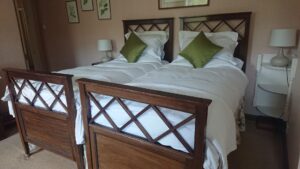 until you twiddled with something or other, whereupon it drained quietly away. My room was smaller, with another high bed and some snowily white, gazillion thread-count old sheets, laundered to a delicious softness and with cut work detail at the turn down. The bathroom of which I had use featured vintage taps, shower, loo and bath, which didn’t have a plug but rather this strange column which had to be twirled and plunged in some way to keep the water in. I didn’t get the hang of it and so had a hasty bath in the peaty-brown, gushing hot water (the Dryburgh fantasy fulfilled
until you twiddled with something or other, whereupon it drained quietly away. My room was smaller, with another high bed and some snowily white, gazillion thread-count old sheets, laundered to a delicious softness and with cut work detail at the turn down. The bathroom of which I had use featured vintage taps, shower, loo and bath, which didn’t have a plug but rather this strange column which had to be twirled and plunged in some way to keep the water in. I didn’t get the hang of it and so had a hasty bath in the peaty-brown, gushing hot water (the Dryburgh fantasy fulfilled 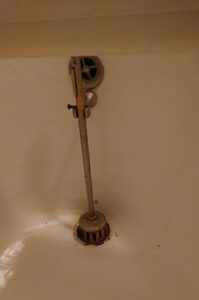 at last!) which was slowly leeching away even as I washed. It was worth it, though. I have never been anywhere like it and it was all rather magical.
at last!) which was slowly leeching away even as I washed. It was worth it, though. I have never been anywhere like it and it was all rather magical.
The scones and cake had gone down enough in time for us to descend to our own private sitting room, where we had chilled wine and a lovely three course home-cooked dinner, most of which had been created from veg picked in the garden that very day. We finished with Eildon’s luscious orange and almond cake served with orange ice cream. Talk about falling on your feet. The evening was full of food, note-taking and route planning, with the kind of on-and-off chat only true friends can have, punctuated with bouts of that full-on belly laughter which is beyond price. The wheel of fortune had well and truly turned,* and I felt deeply thankful for it all. Glad, so glad was I to be alive.
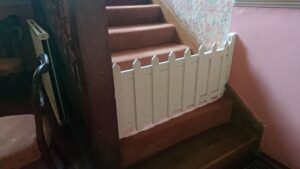
*You can read the poem from which the post’s title came, and learn more about the Elizabethan concept of Fortune’s Wheel, here.